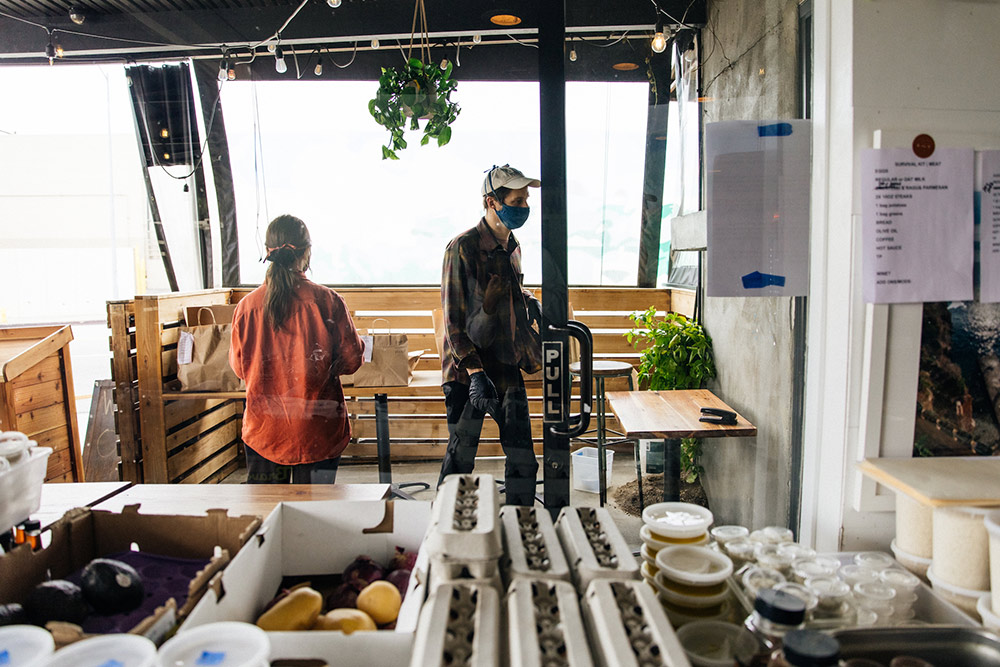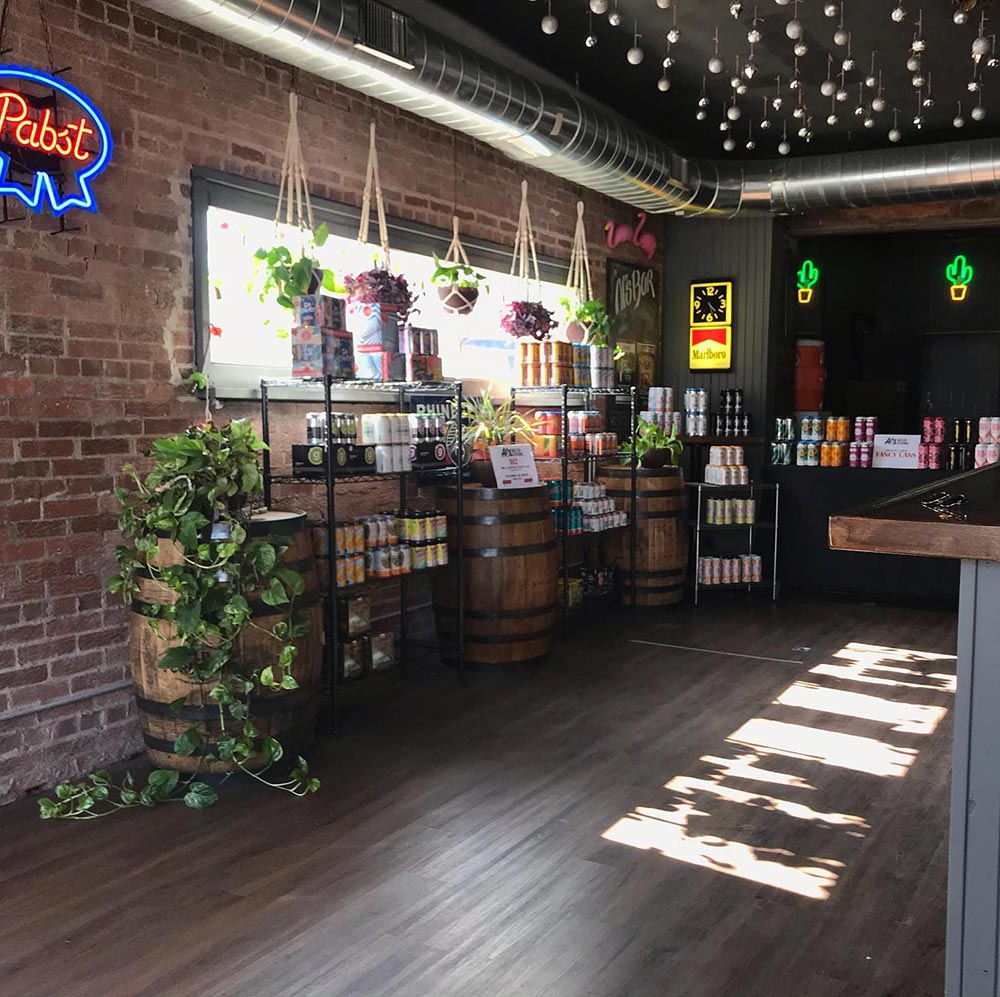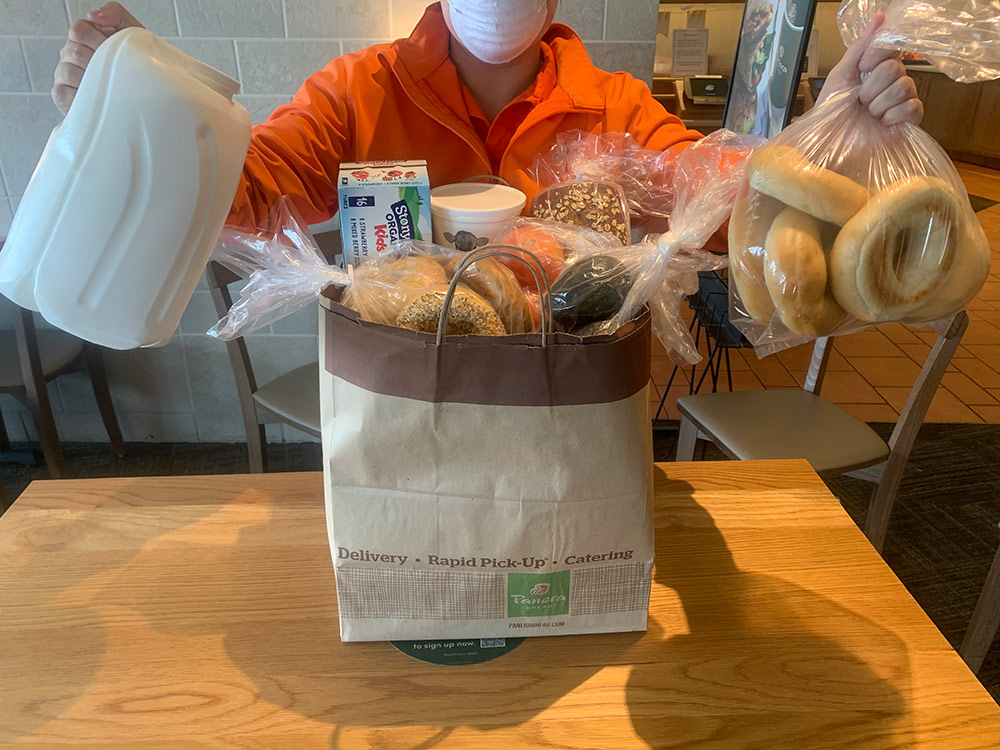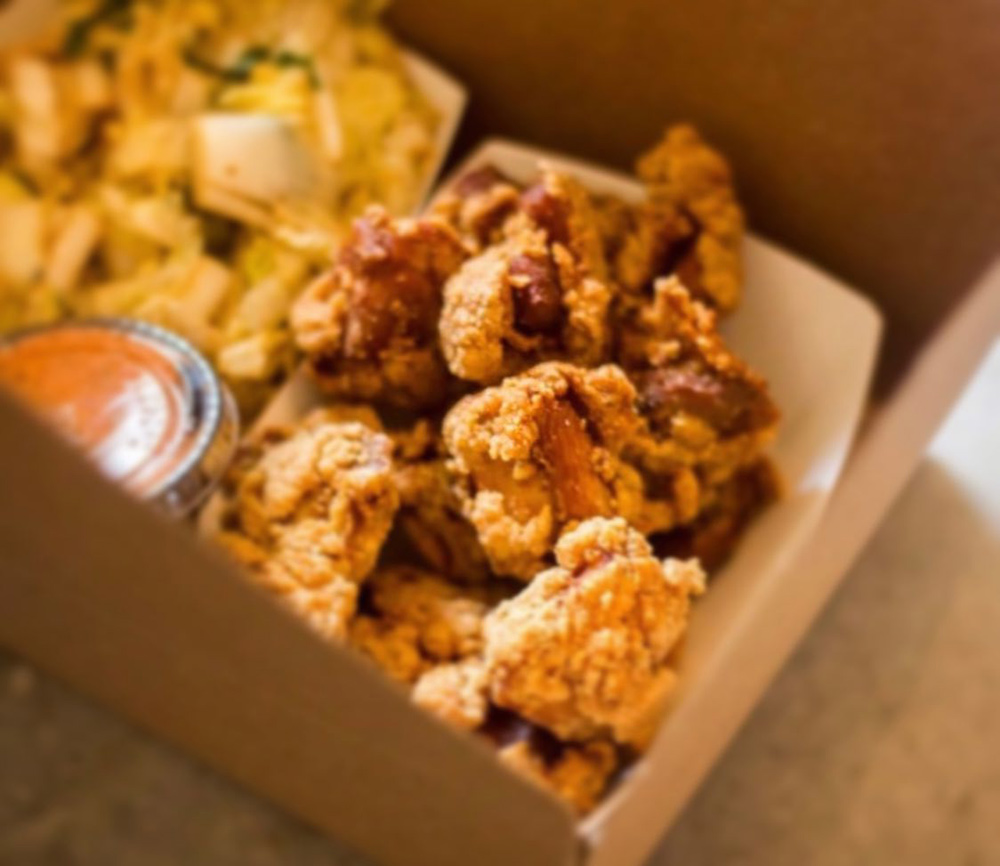随着社会经济活动的全面停摆,外带和外卖成了美国多数尚在营业餐馆和酒吧唯一的经营手段。面对新冠病毒疫情危机,这些个体户老板们不得不使出各种奇思妙招来求生存。
全美各地的众多餐馆都在线上菜单上增加了食品杂货专区,来散卖食品,如大米、豆类、橄榄油、盐、面包、蘸酱、沙拉酱,甚至还有肉块和鱼块。售价平均来看可能比本地杂货店或者街角便利店高一点。但这些餐馆之所以这么做,很多都是寄希望于顾客还会另外购买它们的特制美食,也希望原有的顾客能够多帮衬。
例如,知名大厨柯蒂斯·斯通的好莱坞餐馆Gwen Butcher Shop & Restaurant转向集市模式,主打精选的肉块。他在贝弗利山开设的精致餐厅Maude也推出了全新的菜单来迎合家庭群体,每天轮流变换菜品,如配全谷物芥末酱的腌制烤鸡、波隆那肉酱千层面、春季素食盘菜等等。
“我们要像平常那样不断鞭策自己,”斯通在接受《财富》杂志采访时表示,“只要有客人光顾,我们就会继续经营下去。能够为我们的社区服务,有经过的老顾客和新朋友来取餐表示支持,真是太好了。”
曾经,为了避免浪费,餐馆通常会将店里剩下的食品批量出售。市场研究公司IBISWorld的高级分析师雷切尔•海兰德指出,很少有餐馆会在提供外卖服务的同时,还继续散卖这些商品。然而,虽然只有少数餐馆这么做,但在疫情期间,这一概念正变得越来越受青睐。
“很多散卖商品的餐馆早早就关门,库存一卖完就关门。”海兰德说,“只要有足够的需求确保维持运转,采取这种零售模式的餐馆可能就会继续这么做。”
然而,NPD集团食品行业顾问大卫•波塔拉廷警告称,大多数餐馆都无法在人流量少的地方把量做大,因而很难维持食品杂货业务的经营。“这就是为什么现在的便利店都侧重销售高利润的预制食品。”他解释道,“我们看到餐饮服务业和零售业的渠道界限正在模糊化,餐馆纷纷寻求与零售店建立合作,让后者充当它们的销售点出售预制食品和主食,以及提供方便烘焙的食材或其它食材来帮助消费者准备餐食。疫情结束以后可能会有更多像这样的混合销售模式出现,但目前来看它们只是各家餐馆的权宜之计。”

All Time是洛杉矶卢斯费利斯区的一家颇具人气的社区餐厅,它在按照饮食偏好分别为素食者、鱼素主义者和肉食者提供“必备食品杂货套装”。素食套装售价250美元,包含鸡蛋、意大利面、米饭、土豆、羽衣甘蓝、面包、橄榄油、帕尔马干酪、咖啡、辣椒酱、墨西哥卷饼、奶制品和燕麦奶二选一以及两卷卫生纸。
该餐馆的合伙人阿什莉·威尔斯说道,“我们可以拿到很多很好的供货,不管是肉类、农产品还是各类其它的东西。我们知道我们得让这些东西直接进入我们的社区,同时也要尽可能地多支持与我们长期合作的供应商。”
她和她同为合伙人的丈夫泰勒已经对餐馆的经营模式进行了彻头彻尾的改造,包括所提供的产品以及接单方式。顾客不再需要当面结账;所有的餐食现在都只接受网上下单。他们禁止任何客人进入餐馆;不管是员工还是顾客,所有人都必须佩戴口罩。
“现在我们的经营模式几乎面目全非了,”泰勒说,“我们面临的最大挑战是,让我们的服务和产品质量维持平常忙碌时期那样的高水准。这个过程很有意思,因为我们在投身于外卖世界的同时,也在真正投入到这种经营模式的研发当中,我们会琢磨如何才能够为我们的社区提供最好的外卖服务,毕竟All Time本质上是一家堂食为主的餐馆。”

正当众多餐馆为了维持经营而不得不甩卖店内所有的库存之时,餐饮集团F.L.X. Hospitality的克里斯托弗•贝茨却在这段充满不确定性的时期成功开辟了一个新的收入来源。其集团在纽约芬格湖区有五家餐馆。纽约州酒类法律最近发生变更,开始允许餐馆店内销售红酒。贝茨随即将旗下其中的一家餐馆改造成了纯零售店(名为Super Secret Wine Shop),专门出售他一手精选的红酒(贝茨是品酒大师),同时支持路边提取、本地配送和全美发售。
“我想,即使它做不成,我们也要做好重新开业的准备。”贝茨说道。他的红酒店后来增加了一些新产品(如Blind Tasting Boxes)。这些产品人气颇旺,贝茨也因而得以招回更多的员工。随着销售的高涨,贝茨需要购入新的存货,提供更多的商品选择,以满足顾客的需求。
“说实话,一开始我对停摆既愤怒又沮丧,但之后就开始启动生存模式了。这还是有帮助的。”贝茨称,“我们这些餐馆就是擅长做这个:生存、适应环境和创新。一旦撑过那些阶段,我们就会开始变得越来越兴奋。”
根据美国国家餐馆协会的数据,在疫情导致停摆之前,全美大约有100万家餐馆在营业,其中约一半是独立经营的,员工总数约为1560万人。当中90%的餐馆员工数不到50人。独立餐馆联盟(IRC)的数据显示,餐馆年营收达到8800亿美元,占美国GDP的4%。IRC是厨师和餐馆经理3月发起的一项草根运动。
但是,在自3月9日那周加州开始实施居家令,美国各地相继跟进,非必要行业纷纷停工以来,餐饮业遭到了严重的打击。仅在4月,餐饮服务行业就预计损失超过500亿美元的销售额,截至4月16日已有800多万名餐馆员工被解雇或暂时解雇。据IRC估计,随着当前的经济危机愈演愈烈,这一数字将会扩大到1100万。

萝宾·马塔拉佐是位于纽约州韦斯切斯特县的Villaggio Italiano餐馆的合伙人,她也采取了各种各样的措施来应对经营环境的变化。这家有42年历史的家庭经营餐馆现在出售自制比萨饼套装,供家庭顾客在家自制比萨饼;还出售包含所有原料的套餐,意在为顾客带来餐馆式的用餐体验。
马塔拉佐解释称,她的餐馆之所以推出自制比萨饼套装,是为了满足一些父母的需求,因为他们得整天在家照顾孩子,需要多给孩子找点事做打发时间。她说,“我们在社交媒体上看到了很多关于父母因为照料孩子而抓狂的帖子,因此我们想要帮助他们让孩子忙起来。” Villaggio Italiano每天大约卖出10到15份自制套装,每份售价10美元。里面配有做小馅饼的生面团份量、马苏里拉奶酪和番茄酱。
“馅饼做好以后,不少顾客开始晒照并把我们的店标记出来,太有心了。”马塔拉佐补充道。
马塔拉佐接受了餐馆不能接受堂食的事实,因为她明白这些措施都是为了阻止新冠病毒疫情的扩散。与此同时,她心里很清楚这将会对她的门店生意以及员工造成重大打击,但她也强调身体健康比什么都重要。
“进入这种新常态的头几天,心情非常沮丧。”马塔拉佐回忆说,“不得不暂时解雇员工,生意下滑,也想到为我们工作了15到30年的员工可能找不到工作,所有的这一切都让人心碎,但我们也无能为力,我们必须得尽快想出新法规下的经营办法。”
马塔拉佐指出,最初几天销售额下降了80%以上,因而她的店不得不解雇80%的员工。该比萨饼店停止了所有的广告宣传,同时也在不断削减食物的采购量。但随着时间的推移,经营状况总算迎来好转。
目前,Villaggio Italiano还有两名厨师、两名另外的比萨饼厨师、一名接电话的员工和三名配送师傅。外卖业务增长迅猛,因此该餐厅增加了两名配送师傅。“电话响个不停,我们对此永远心存感激。有很多顾客过来取餐时还会远远地向我们问好,送上美好的祝福。”
马塔拉佐坦言,她的店从未想过要推出礼券——堂食业务停止初期兴起的一种模式,意在快速给餐馆带来现金流——因为她了解到顾客们也在失去工作和经济来源。“我们当时决定只管尽力地去经营,看看会发生什么,毕竟我们都无法改变现状。”她解释道。

肯塔基州的酒吧和餐馆与纽约州的同行在同一周内受到经营限制,只能提供外卖、路边取餐和外带。
“我们的音乐厅和酒吧一夜之间就死翘翘了。”肯塔基州列克星敦Al’s Bar合伙人塞思•布鲁尔说道。
布鲁尔说,大致评估了一番后,他和他的生意搭档蒂姆·斯莫尔发现他们无法继续合法经营下去:肯塔基州的酒类法律还没有放宽,餐馆和提供食品的酒吧不能出售外带酒水。Al 's Bar之前在建造厨房,但还没有完成改造工程的收官阶段,在经营受限之前没有出售过任何的食品,因此它现在不能转而出售食品,来弥补酒精饮料的销售损失。
布鲁尔说,雪上加霜的是,由于当地政府实施针对疫情的安全防护措施,他们无法让卫生部门过来检查他们的厨房,所以后备计划无法展开。他们原本打算招募一些失业的餐馆同行来开售食品。“那个计划原本可以给我们的一些朋友带来经济收入,也会让我们得以在遵守行政命令的情况下营业。该行政命令允许出售食品的商户在出售食品的同时出售酒水。”
Al 's Bar的生意随即一落千丈。然而,在对手头上的东西重新思量一番后,布鲁尔和斯莫尔意识到,他们还有一项资产:原包装啤酒零售许可证,这在之前似乎难以派上用场。由此,Al 's Bar一夜之间从酒吧变成了啤酒商店(Al 's Bar Store)。
“我们想到我们可以变成一家啤酒商店,所以我们就这么干了。”布鲁尔解释道,“我俩中有一个拥有城里的精品酒行的零售经验,了解零售利润率,也熟知多家啤酒经销商以及它们的品牌声誉,因此我们有能力把我们的酒吧变成一家零售店。”
他们的啤酒店每天的营业时间相对有限,从下午4点开到晚上8点(疫情发生前,从下午5点开到凌晨2点30分),主吧台区改造成了在售啤酒的展示区。
据布鲁尔说,最初似乎只有本地居民和常客来光顾——他们希望尽可能地为酒吧的经营和它的员工出一份力。但几周过去,那些“爱心小费”有所减少,啤酒销售则稳步上扬。
“我们正在解决我们社区的一个需求痛点,我们主要向他们出售精酿啤酒,而过往他们得开车去购买好啤酒,又或者只能将就购买附近加油站供应的啤酒。”布鲁尔说道,“有些顾客还一直叫我们在疫情结束后继续这么卖。”

大刀阔斧改变经营模式的并不只有小型餐饮场所。Panera Bread全美各地的门店已经从满足午餐高峰需求转向销售基本食品。除了面包和百吉饼,Panera Grocery还出售农产品和奶制品(从几加仑的牛奶到希腊酸奶,选择多样),支持到店提取和无接触式配送。
这一模式推向全美各地的门店,加盟店和自营店也参与其中。Panera在全美大约有2200家门店,其中15%已经暂时关闭。旗下几乎每一家营业的咖啡门店都有参与。在营业的门店中(将近1900家),有95%在处理Panera Grocery食品杂货订单。
“随着新冠病毒的袭来,我们知道我们需要做更多的事情来满足我们的顾客,适应他们的需求变化。”Panera首席执行官尼伦·乔杜里指出,“如今,由于需求高涨,各地的人们都难以买到必需品,难以获得准时的食品杂货配送服务,他们也希望在出门采购必需品时能够尽量减少停车次数。”
乔杜里说,随着时间的推移,Panera Grocery希望进一步拓展业务,为顾客提供更多的基本食品杂货。至于Panera Grocery业务是否会在疫情结束后长期保留,她说尚不排除这一可能性。“我们将一如既往地关注消费者的需求——是否保留,完全取决于我们的消费者在疫情结束后是否仍然认为这些日常食品杂货值得购买。”
生存没有秘诀可言
但这些都不是一夜之间的成功故事。也许硅谷的独角兽公司让商业模式的“航向转变”显得轻而易举,但成功的例子其实寥寥无几。
在漫长的冬季接近尾声之时,F.L.X. Hospitality旗下的两家新门店几近完工,开业在即,它还打算5月再开设四家。贝茨的一家F.L.X. Fry Bird新餐馆才刚在2月开业,生意做得有声有色。
“说实话,我们遭遇的仿佛是山崩海啸,无可阻挡。在多个州纷纷开始停摆后,我们就招架不住了。更甚的是,这波冲击还没达到最高峰,直至我们所在的州也开始停摆。”贝茨说道,“无论我们有多努力,也无济于事,计划总是赶不上变化。”
3月15日,纽约州州长安德鲁·库默宣布,纽约州所有餐饮场所仅允许外带或外卖,禁止堂食。贝茨说,听到这一消息后,他当场哭了。但他得冷静下来,给经理们逐个发短信,通知他们准备好关店一段时间。然后,他开车前往旗下的餐馆,一家一家地跑,去当面与经理们说明状况,并向团队发表讲话。“我得在5个小时内告诉我的整个团队,我不再能够为他们提供工作了。”贝茨称,“这是我一生中最艰难的一天。”

在3月中旬停摆之后,贝茨的团队决定尝试让Fry Bird继续营业,提供外带餐食,同时增加外卖服务。贝茨让团队中最可靠的几个成员留下来帮忙,约定先试着营业一周看看。生意一天比一天忙碌。每一天,他们都能多招回一名团队成员。3月15日停摆当天,贝茨的餐饮集团才刚刚完成F.L.X. Provisions的扩建,增设了一间品酒室和一间美食贮藏室。这家店原来打算两天后正式开业——后来确实开业了,只不过没有按照原来的计划。在该团队仓促准备一番后,开业的变成了Super Secret Wine Shop红酒店。
Fry Bird的销售状况一直起伏不定,贝茨坦言生意有所下滑,但也指出情况并没有非常糟糕。“我们尽力而为,严格管理经营效率,顺应市场环境的变化。总的来说,我们保住了一些团队成员的工作了,算对公司负责了,也没有严重影响我们应对这场危机的能力。”然而,Super Secret Wine Shop的生意则节节高升。这家红酒店拥有新的、更加宽敞的空间,也得益于SLA(服务级别协议)的变动得以出售更多的品类。贝茨说,该店反而给他和他的团队带来了多得多的机会,同时也带来了经营弹性,让他们可以做一些他们从未做过的事情。
“政府宣布全面停摆的那个星期一,我们对整个团队进行了裁员,并削减了所有可削减的开支项目。”贝茨说,“我想,为了确保我们能够挺过这场危机,我们必须得那么做。一切要看这场危机持续多久——我们一度要撑不下去了——但所幸我们迅速作出了应对,为自己争取了一点喘息的时间。那些决定确保我们有机会在疫情结束后重建那些工作岗位,重新吸引游客光顾,并最终重整我们的经济状况。”
F.L.X. Hospitality申请了薪资保护项目的援助,但和许多其它的申请者一样,该公司也在等待获批。“考虑到债务免除和偿还方面的指引仍然没有明确,即使能够在未来几周内拿到那笔救助金,你也会安不下心来。”贝茨说道。
会恢复如前吗?
对于餐饮业是否将会恢复如前,贝茨称不好说,现在预测还言之过早。“我个人觉得,我们作为人需要与别人面对面接触。我希望,最终我们将会变得想要更多地与他人连接沟通——不再在跟人吃饭时埋头玩手机,而是与我们周围的人连接互动。”这正是他其中的一家餐馆F.L.X. Table的主打模式:一家由14人组成的主厨菜单餐厅,灵感来自一次晚宴。他希望,疫情结束后我们都会有那样的渴望。
“人们正在认识到,社交上的匮乏与营养上的匮乏没有什么不同:二者都是我们所渴望和需要的东西。”贝茨称,“尽管如此,我们的‘常态’现在每天都在变化。目前来看,下周的情况还不得而知,所以对我们来说,预测下个月的情况就是在浪费时间。”
纽约的餐饮场所被告知堂食禁令至少要持续到5月15日,纽约北部县区的餐馆届时或许能重新开放,相较之下,纽约市内的餐馆则预计还要等待很长一段时间才能开放。贝茨坦称,鉴于还有几周就到了,这或许是件好事。但他也指出,怕就怕在重新开放时消费者的信心还没有恢复过来。因此,他打算至少等到6月15日以后才让旗下的餐馆全面恢复开放。“我很清楚,现在的情况可能会持续更长的时间,但考虑到现在还有那么多影响着我们的事情需要关注和思考,过多的猜测也无济于事。”贝茨说道。
贝茨仍然心存乐观。“一旦我们从悲伤和沮丧情绪中走出来,开始去做我们平常会做的事情——创造——我每天早上醒来都会十分兴奋。”他说,“我等不及要做电子表格,试验这样那样的新主意了,也等不及要接触外面的人寻求建立合作了。”
Villaggio Italiano比萨饼店的团队已经开始考虑重新开放后需要如何改变经营模式了。首先,餐厅内要削减30%的餐桌,以确保顾客之间能够保持安全距离。其次,为每张餐桌配备洗手液供人们使用,安排人手勤换餐桌布,使用多种清洁剂,确保尽量减少或清除餐厅内的任何塑料。
“我个人认为,任何时候不管发生什么改变生活的重大事情,人们都会出现暂时性的变化,但最终都会变回原来那样。”马塔拉佐指出,“我想,这一次影响非常巨大,所以人们恢复起来需要一定的时日,可能要过几个月人们才会重新变回往常那样。至于我们的员工是否会佩戴手套和口罩,要看医疗部门和政府下放的通知。”
从长远来看,马塔拉佐预计外卖和外带订单会增加,而堂食业务则可能要在餐厅重新开放后很长一段时间才恢复正常。“我们只能根据目前的情况做出这一预测,希望一切都能尽快好转。”她表示,“我知道我代表着我自己和我的员工,我们想说的是,我们都期待着能够再次拥抱每一个人。”
布鲁尔承认,转向啤酒店模式“一开始只是孤注一掷,”但后来却成了救命稻草,尽管可能只是暂时性的。他们寄望于依靠那种模式撑到恢复正常营业,布鲁尔对目前的成功也非常满意,虽然不算很成功。未来转回正常的经营模式以后,他很可能会继续提供和宣传外带特色酒品。
然而,在布鲁尔看来,人们将需要一段时间才能像往常那样放心前往公共的社会环境,对于餐饮场所的经理们来说这将会是一个不小的挑战。“毕竟,外出和身处充斥着陌生人的封闭空间,已经成了一个不正常的想法了。”他说,“该死的,在居家隔离和保持社交距离的时期,就连与人握手都让人感觉很怪异,很陌生。”
布鲁尔称,短期来看,他的酒吧必须得继续推进法律允许的业务:销售外带啤酒。然而,他觉得现在生存都成问题,根本谈不上长期发展。“我们这些小商户有很多都没有足够的现金储备或创收渠道来继续抗争,哪怕债务偿还可以延期,债务也终究还是债务。”布鲁尔指出,“如果这种情况再持续六个月,那我们必定要关门大吉。就这么简单。”(财富中文网)
译者:万志文
随着社会经济活动的全面停摆,外带和外卖成了美国多数尚在营业餐馆和酒吧唯一的经营手段。面对新冠病毒疫情危机,这些个体户老板们不得不使出各种奇思妙招来求生存。
全美各地的众多餐馆都在线上菜单上增加了食品杂货专区,来散卖食品,如大米、豆类、橄榄油、盐、面包、蘸酱、沙拉酱,甚至还有肉块和鱼块。售价平均来看可能比本地杂货店或者街角便利店高一点。但这些餐馆之所以这么做,很多都是寄希望于顾客还会另外购买它们的特制美食,也希望原有的顾客能够多帮衬。
例如,知名大厨柯蒂斯·斯通的好莱坞餐馆Gwen Butcher Shop & Restaurant转向集市模式,主打精选的肉块。他在贝弗利山开设的精致餐厅Maude也推出了全新的菜单来迎合家庭群体,每天轮流变换菜品,如配全谷物芥末酱的腌制烤鸡、波隆那肉酱千层面、春季素食盘菜等等。
“我们要像平常那样不断鞭策自己,”斯通在接受《财富》杂志采访时表示,“只要有客人光顾,我们就会继续经营下去。能够为我们的社区服务,有经过的老顾客和新朋友来取餐表示支持,真是太好了。”
曾经,为了避免浪费,餐馆通常会将店里剩下的食品批量出售。市场研究公司IBISWorld的高级分析师雷切尔•海兰德指出,很少有餐馆会在提供外卖服务的同时,还继续散卖这些商品。然而,虽然只有少数餐馆这么做,但在疫情期间,这一概念正变得越来越受青睐。
“很多散卖商品的餐馆早早就关门,库存一卖完就关门。”海兰德说,“只要有足够的需求确保维持运转,采取这种零售模式的餐馆可能就会继续这么做。”
然而,NPD集团食品行业顾问大卫•波塔拉廷警告称,大多数餐馆都无法在人流量少的地方把量做大,因而很难维持食品杂货业务的经营。“这就是为什么现在的便利店都侧重销售高利润的预制食品。”他解释道,“我们看到餐饮服务业和零售业的渠道界限正在模糊化,餐馆纷纷寻求与零售店建立合作,让后者充当它们的销售点出售预制食品和主食,以及提供方便烘焙的食材或其它食材来帮助消费者准备餐食。疫情结束以后可能会有更多像这样的混合销售模式出现,但目前来看它们只是各家餐馆的权宜之计。”
All Time是洛杉矶卢斯费利斯区的一家颇具人气的社区餐厅,它在按照饮食偏好分别为素食者、鱼素主义者和肉食者提供“必备食品杂货套装”。素食套装售价250美元,包含鸡蛋、意大利面、米饭、土豆、羽衣甘蓝、面包、橄榄油、帕尔马干酪、咖啡、辣椒酱、墨西哥卷饼、奶制品和燕麦奶二选一以及两卷卫生纸。
该餐馆的合伙人阿什莉·威尔斯说道,“我们可以拿到很多很好的供货,不管是肉类、农产品还是各类其它的东西。我们知道我们得让这些东西直接进入我们的社区,同时也要尽可能地多支持与我们长期合作的供应商。”
她和她同为合伙人的丈夫泰勒已经对餐馆的经营模式进行了彻头彻尾的改造,包括所提供的产品以及接单方式。顾客不再需要当面结账;所有的餐食现在都只接受网上下单。他们禁止任何客人进入餐馆;不管是员工还是顾客,所有人都必须佩戴口罩。
“现在我们的经营模式几乎面目全非了,”泰勒说,“我们面临的最大挑战是,让我们的服务和产品质量维持平常忙碌时期那样的高水准。这个过程很有意思,因为我们在投身于外卖世界的同时,也在真正投入到这种经营模式的研发当中,我们会琢磨如何才能够为我们的社区提供最好的外卖服务,毕竟All Time本质上是一家堂食为主的餐馆。”
正当众多餐馆为了维持经营而不得不甩卖店内所有的库存之时,餐饮集团F.L.X. Hospitality的克里斯托弗•贝茨却在这段充满不确定性的时期成功开辟了一个新的收入来源。其集团在纽约芬格湖区有五家餐馆。纽约州酒类法律最近发生变更,开始允许餐馆店内销售红酒。贝茨随即将旗下其中的一家餐馆改造成了纯零售店(名为Super Secret Wine Shop),专门出售他一手精选的红酒(贝茨是品酒大师),同时支持路边提取、本地配送和全美发售。
“我想,即使它做不成,我们也要做好重新开业的准备。”贝茨说道。他的红酒店后来增加了一些新产品(如Blind Tasting Boxes)。这些产品人气颇旺,贝茨也因而得以招回更多的员工。随着销售的高涨,贝茨需要购入新的存货,提供更多的商品选择,以满足顾客的需求。
“说实话,一开始我对停摆既愤怒又沮丧,但之后就开始启动生存模式了。这还是有帮助的。”贝茨称,“我们这些餐馆就是擅长做这个:生存、适应环境和创新。一旦撑过那些阶段,我们就会开始变得越来越兴奋。”
根据美国国家餐馆协会的数据,在疫情导致停摆之前,全美大约有100万家餐馆在营业,其中约一半是独立经营的,员工总数约为1560万人。当中90%的餐馆员工数不到50人。独立餐馆联盟(IRC)的数据显示,餐馆年营收达到8800亿美元,占美国GDP的4%。IRC是厨师和餐馆经理3月发起的一项草根运动。
但是,在自3月9日那周加州开始实施居家令,美国各地相继跟进,非必要行业纷纷停工以来,餐饮业遭到了严重的打击。仅在4月,餐饮服务行业就预计损失超过500亿美元的销售额,截至4月16日已有800多万名餐馆员工被解雇或暂时解雇。据IRC估计,随着当前的经济危机愈演愈烈,这一数字将会扩大到1100万。
这家名为Super Secret Wine Shop的红酒店铺原本是一家准备开业的餐馆,叫F.L.X. Provisions。
萝宾·马塔拉佐是位于纽约州韦斯切斯特县的Villaggio Italiano餐馆的合伙人,她也采取了各种各样的措施来应对经营环境的变化。这家有42年历史的家庭经营餐馆现在出售自制比萨饼套装,供家庭顾客在家自制比萨饼;还出售包含所有原料的套餐,意在为顾客带来餐馆式的用餐体验。
马塔拉佐解释称,她的餐馆之所以推出自制比萨饼套装,是为了满足一些父母的需求,因为他们得整天在家照顾孩子,需要多给孩子找点事做打发时间。她说,“我们在社交媒体上看到了很多关于父母因为照料孩子而抓狂的帖子,因此我们想要帮助他们让孩子忙起来。” Villaggio Italiano每天大约卖出10到15份自制套装,每份售价10美元。里面配有做小馅饼的生面团份量、马苏里拉奶酪和番茄酱。
“馅饼做好以后,不少顾客开始晒照并把我们的店标记出来,太有心了。”马塔拉佐补充道。
马塔拉佐接受了餐馆不能接受堂食的事实,因为她明白这些措施都是为了阻止新冠病毒疫情的扩散。与此同时,她心里很清楚这将会对她的门店生意以及员工造成重大打击,但她也强调身体健康比什么都重要。
“进入这种新常态的头几天,心情非常沮丧。”马塔拉佐回忆说,“不得不暂时解雇员工,生意下滑,也想到为我们工作了15到30年的员工可能找不到工作,所有的这一切都让人心碎,但我们也无能为力,我们必须得尽快想出新法规下的经营办法。”
马塔拉佐指出,最初几天销售额下降了80%以上,因而她的店不得不解雇80%的员工。该比萨饼店停止了所有的广告宣传,同时也在不断削减食物的采购量。但随着时间的推移,经营状况总算迎来好转。
目前,Villaggio Italiano还有两名厨师、两名另外的比萨饼厨师、一名接电话的员工和三名配送师傅。外卖业务增长迅猛,因此该餐厅增加了两名配送师傅。“电话响个不停,我们对此永远心存感激。有很多顾客过来取餐时还会远远地向我们问好,送上美好的祝福。”
马塔拉佐坦言,她的店从未想过要推出礼券——堂食业务停止初期兴起的一种模式,意在快速给餐馆带来现金流——因为她了解到顾客们也在失去工作和经济来源。“我们当时决定只管尽力地去经营,看看会发生什么,毕竟我们都无法改变现状。”她解释道。
肯塔基州的酒吧和餐馆与纽约州的同行在同一周内受到经营限制,只能提供外卖、路边取餐和外带。
“我们的音乐厅和酒吧一夜之间就死翘翘了。”肯塔基州列克星敦Al’s Bar合伙人塞思•布鲁尔说道。
布鲁尔说,大致评估了一番后,他和他的生意搭档蒂姆·斯莫尔发现他们无法继续合法经营下去:肯塔基州的酒类法律还没有放宽,餐馆和提供食品的酒吧不能出售外带酒水。Al 's Bar之前在建造厨房,但还没有完成改造工程的收官阶段,在经营受限之前没有出售过任何的食品,因此它现在不能转而出售食品,来弥补酒精饮料的销售损失。
布鲁尔说,雪上加霜的是,由于当地政府实施针对疫情的安全防护措施,他们无法让卫生部门过来检查他们的厨房,所以后备计划无法展开。他们原本打算招募一些失业的餐馆同行来开售食品。“那个计划原本可以给我们的一些朋友带来经济收入,也会让我们得以在遵守行政命令的情况下营业。该行政命令允许出售食品的商户在出售食品的同时出售酒水。”
Al 's Bar的生意随即一落千丈。然而,在对手头上的东西重新思量一番后,布鲁尔和斯莫尔意识到,他们还有一项资产:原包装啤酒零售许可证,这在之前似乎难以派上用场。由此,Al 's Bar一夜之间从酒吧变成了啤酒商店(Al 's Bar Store)。
“我们想到我们可以变成一家啤酒商店,所以我们就这么干了。”布鲁尔解释道,“我俩中有一个拥有城里的精品酒行的零售经验,了解零售利润率,也熟知多家啤酒经销商以及它们的品牌声誉,因此我们有能力把我们的酒吧变成一家零售店。”
他们的啤酒店每天的营业时间相对有限,从下午4点开到晚上8点(疫情发生前,从下午5点开到凌晨2点30分),主吧台区改造成了在售啤酒的展示区。
据布鲁尔说,最初似乎只有本地居民和常客来光顾——他们希望尽可能地为酒吧的经营和它的员工出一份力。但几周过去,那些“爱心小费”有所减少,啤酒销售则稳步上扬。
“我们正在解决我们社区的一个需求痛点,我们主要向他们出售精酿啤酒,而过往他们得开车去购买好啤酒,又或者只能将就购买附近加油站供应的啤酒。”布鲁尔说道,“有些顾客还一直叫我们在疫情结束后继续这么卖。”
大刀阔斧改变经营模式的并不只有小型餐饮场所。Panera Bread全美各地的门店已经从满足午餐高峰需求转向销售基本食品。除了面包和百吉饼,Panera Grocery还出售农产品和奶制品(从几加仑的牛奶到希腊酸奶,选择多样),支持到店提取和无接触式配送。
这一模式推向全美各地的门店,加盟店和自营店也参与其中。Panera在全美大约有2200家门店,其中15%已经暂时关闭。旗下几乎每一家营业的咖啡门店都有参与。在营业的门店中(将近1900家),有95%在处理Panera Grocery食品杂货订单。
“随着新冠病毒的袭来,我们知道我们需要做更多的事情来满足我们的顾客,适应他们的需求变化。”Panera首席执行官尼伦·乔杜里指出,“如今,由于需求高涨,各地的人们都难以买到必需品,难以获得准时的食品杂货配送服务,他们也希望在出门采购必需品时能够尽量减少停车次数。”
乔杜里说,随着时间的推移,Panera Grocery希望进一步拓展业务,为顾客提供更多的基本食品杂货。至于Panera Grocery业务是否会在疫情结束后长期保留,她说尚不排除这一可能性。“我们将一如既往地关注消费者的需求——是否保留,完全取决于我们的消费者在疫情结束后是否仍然认为这些日常食品杂货值得购买。”
生存没有秘诀可言
但这些都不是一夜之间的成功故事。也许硅谷的独角兽公司让商业模式的“航向转变”显得轻而易举,但成功的例子其实寥寥无几。
在漫长的冬季接近尾声之时,F.L.X. Hospitality旗下的两家新门店几近完工,开业在即,它还打算5月再开设四家。贝茨的一家F.L.X. Fry Bird新餐馆才刚在2月开业,生意做得有声有色。
“说实话,我们遭遇的仿佛是山崩海啸,无可阻挡。在多个州纷纷开始停摆后,我们就招架不住了。更甚的是,这波冲击还没达到最高峰,直至我们所在的州也开始停摆。”贝茨说道,“无论我们有多努力,也无济于事,计划总是赶不上变化。”
3月15日,纽约州州长安德鲁·库默宣布,纽约州所有餐饮场所仅允许外带或外卖,禁止堂食。贝茨说,听到这一消息后,他当场哭了。但他得冷静下来,给经理们逐个发短信,通知他们准备好关店一段时间。然后,他开车前往旗下的餐馆,一家一家地跑,去当面与经理们说明状况,并向团队发表讲话。“我得在5个小时内告诉我的整个团队,我不再能够为他们提供工作了。”贝茨称,“这是我一生中最艰难的一天。”
在3月中旬停摆之后,贝茨的团队决定尝试让Fry Bird继续营业,提供外带餐食,同时增加外卖服务。贝茨让团队中最可靠的几个成员留下来帮忙,约定先试着营业一周看看。生意一天比一天忙碌。每一天,他们都能多招回一名团队成员。3月15日停摆当天,贝茨的餐饮集团才刚刚完成F.L.X. Provisions的扩建,增设了一间品酒室和一间美食贮藏室。这家店原来打算两天后正式开业——后来确实开业了,只不过没有按照原来的计划。在该团队仓促准备一番后,开业的变成了Super Secret Wine Shop红酒店。
Fry Bird的销售状况一直起伏不定,贝茨坦言生意有所下滑,但也指出情况并没有非常糟糕。“我们尽力而为,严格管理经营效率,顺应市场环境的变化。总的来说,我们保住了一些团队成员的工作了,算对公司负责了,也没有严重影响我们应对这场危机的能力。”然而,Super Secret Wine Shop的生意则节节高升。这家红酒店拥有新的、更加宽敞的空间,也得益于SLA(服务级别协议)的变动得以出售更多的品类。贝茨说,该店反而给他和他的团队带来了多得多的机会,同时也带来了经营弹性,让他们可以做一些他们从未做过的事情。
“政府宣布全面停摆的那个星期一,我们对整个团队进行了裁员,并削减了所有可削减的开支项目。”贝茨说,“我想,为了确保我们能够挺过这场危机,我们必须得那么做。一切要看这场危机持续多久——我们一度要撑不下去了——但所幸我们迅速作出了应对,为自己争取了一点喘息的时间。那些决定确保我们有机会在疫情结束后重建那些工作岗位,重新吸引游客光顾,并最终重整我们的经济状况。”
F.L.X. Hospitality申请了薪资保护项目的援助,但和许多其它的申请者一样,该公司也在等待获批。“考虑到债务免除和偿还方面的指引仍然没有明确,即使能够在未来几周内拿到那笔救助金,你也会安不下心来。”贝茨说道。
会恢复如前吗?
对于餐饮业是否将会恢复如前,贝茨称不好说,现在预测还言之过早。“我个人觉得,我们作为人需要与别人面对面接触。我希望,最终我们将会变得想要更多地与他人连接沟通——不再在跟人吃饭时埋头玩手机,而是与我们周围的人连接互动。”这正是他其中的一家餐馆F.L.X. Table的主打模式:一家由14人组成的主厨菜单餐厅,灵感来自一次晚宴。他希望,疫情结束后我们都会有那样的渴望。
“人们正在认识到,社交上的匮乏与营养上的匮乏没有什么不同:二者都是我们所渴望和需要的东西。”贝茨称,“尽管如此,我们的‘常态’现在每天都在变化。目前来看,下周的情况还不得而知,所以对我们来说,预测下个月的情况就是在浪费时间。”
纽约的餐饮场所被告知堂食禁令至少要持续到5月15日,纽约北部县区的餐馆届时或许能重新开放,相较之下,纽约市内的餐馆则预计还要等待很长一段时间才能开放。贝茨坦称,鉴于还有几周就到了,这或许是件好事。但他也指出,怕就怕在重新开放时消费者的信心还没有恢复过来。因此,他打算至少等到6月15日以后才让旗下的餐馆全面恢复开放。“我很清楚,现在的情况可能会持续更长的时间,但考虑到现在还有那么多影响着我们的事情需要关注和思考,过多的猜测也无济于事。”贝茨说道。
贝茨仍然心存乐观。“一旦我们从悲伤和沮丧情绪中走出来,开始去做我们平常会做的事情——创造——我每天早上醒来都会十分兴奋。”他说,“我等不及要做电子表格,试验这样那样的新主意了,也等不及要接触外面的人寻求建立合作了。”
Villaggio Italiano比萨饼店的团队已经开始考虑重新开放后需要如何改变经营模式了。首先,餐厅内要削减30%的餐桌,以确保顾客之间能够保持安全距离。其次,为每张餐桌配备洗手液供人们使用,安排人手勤换餐桌布,使用多种清洁剂,确保尽量减少或清除餐厅内的任何塑料。
“我个人认为,任何时候不管发生什么改变生活的重大事情,人们都会出现暂时性的变化,但最终都会变回原来那样。”马塔拉佐指出,“我想,这一次影响非常巨大,所以人们恢复起来需要一定的时日,可能要过几个月人们才会重新变回往常那样。至于我们的员工是否会佩戴手套和口罩,要看医疗部门和政府下放的通知。”
从长远来看,马塔拉佐预计外卖和外带订单会增加,而堂食业务则可能要在餐厅重新开放后很长一段时间才恢复正常。“我们只能根据目前的情况做出这一预测,希望一切都能尽快好转。”她表示,“我知道我代表着我自己和我的员工,我们想说的是,我们都期待着能够再次拥抱每一个人。”
布鲁尔承认,转向啤酒店模式“一开始只是孤注一掷,”但后来却成了救命稻草,尽管可能只是暂时性的。他们寄望于依靠那种模式撑到恢复正常营业,布鲁尔对目前的成功也非常满意,虽然不算很成功。未来转回正常的经营模式以后,他很可能会继续提供和宣传外带特色酒品。
然而,在布鲁尔看来,人们将需要一段时间才能像往常那样放心前往公共的社会环境,对于餐饮场所的经理们来说这将会是一个不小的挑战。“毕竟,外出和身处充斥着陌生人的封闭空间,已经成了一个不正常的想法了。”他说,“该死的,在居家隔离和保持社交距离的时期,就连与人握手都让人感觉很怪异,很陌生。”
布鲁尔称,短期来看,他的酒吧必须得继续推进法律允许的业务:销售外带啤酒。然而,他觉得现在生存都成问题,根本谈不上长期发展。“我们这些小商户有很多都没有足够的现金储备或创收渠道来继续抗争,哪怕债务偿还可以延期,债务也终究还是债务。”布鲁尔指出,“如果这种情况再持续六个月,那我们必定要关门大吉。就这么简单。”(财富中文网)
译者:万志文
With takeout and delivery as the only means of business for most restaurants and bars still open across the United States, owners of these independent establishments have found themselves forced to get desperately creative to ride out the coronavirus pandemic.
From coast to coast, many restaurants have added grocery sections to their online menus, selling à la carte pantry items such as rice, beans, olive oil, salt, bread, dips, salad dressings, and even butcher cuts of meat and fish. Prices might be higher on average at these restaurants turned larder purveyors than those at your local grocery store or even the corner convenience shop. But many of these eateries are trading on the hopes that customers will respond to both the particular culinary expertise these locations offer as well as the loyalty of its customer base.
Chef Curtis Stone’s Gwen Butcher Shop & Restaurant in Hollywood, for example, shifted to a marketplace model with a focus on select meat cuts, and his 24-seat fine dining space, Maude, in Beverly Hills, has a brand-new menu catering to families, with rotating items including a fully brined and organic spatchcocked chicken with whole grain mustard spaetzle, a lasagna Bolognese, and a spring vegan platter.
“It’s important to keep pushing ourselves just as we did under normal circumstances,” Stone tells Fortune. “We’ll keep going as long as we have the patronage of our guests. It’s been wonderful to be in a position to serve the community and see our loyal regulars from the dining room and new friends, who are stopping by and picking up items to show their support.”
In the past, selling off existing inventory as wholesale products was typically a way for restaurants to avoid food waste. Very few establishments have taken this a step further by continuing to retail these items in addition to providing takeout services, according to Rachel Hyland, a senior analyst at market research firm IBISWorld. But while only a minority of restaurants are going this route, the concept has increased in popularity throughout the pandemic.
“Most operators that were retailing their goods have already closed, shutting their door once their inventory was depleted,” says Hyland. “Operators that are sustaining this retail model are likely to continue so long as there is enough demand to warrant the costs of remaining open.”
However, most restaurant operators won’t be able to do enough volume in a small footprint to make food staples a sustainable business, warns David Portalatin, a food industry advisor at The NPD Group. "It’s the reason why convenience stores today are all emphasizing higher margin prepared foods," he explains. "We are seeing blurring of channel lines in food service and retail as restaurants seek out retailers as outlets for prepared food as well as selling staples, like take-and-bake items or other components to help consumers prepare a meal. We may see more hybrid models emerge post-pandemic, but these are really stop-gap measures for restaurants now."
All Time, a popular neighborhood restaurant in the Los Feliz district of Los Angeles, is selling “grocery survival kits,” curated by dietary preference, for vegetarians, pescatarians, and meat eaters. For $250, the vegetarian box includes eggs, dry pasta, dry rice, potatoes, kale, bread, olive oil, Parmesan cheese, coffee, hot sauce, a taco kit, the choice of dairy or , and two rolls of toilet paper.
“We have such immense access to the best stuff around, from meat to produce and everything in between, so we knew we had to make these items available directly to our community, and also continue to support our longtime vendors as much as possible,” says co-owner Ashley Wells.
She and her husband (and co-owner), Tyler, have completely reengineered the operation—both in what they offer and in the way they conduct business. Payment transactions are no longer conducted in person; everything is now exclusively ordered online. And no guests are allowed to come inside the restaurant; everyone—employees and patrons—must wear masks.
“The business model is almost unrecognizable now,” Tyler says. “Our biggest challenges were keeping up and maintaining our high standards of both service and product quality in the midst of being a very busy neighborhood restaurant. It’s funny, because we got plunged into the world of takeaway just as we were really diving into some R&D for this very model, and thinking about how we could best serve the neighborhood with takeaway offerings as All Time is really a dine-in restaurant.”
While many restaurateurs have been forced to sell off all existing inventory just to stay afloat, Christopher Bates— founder of five restaurants in New York’s Finger Lakes region within his F.L.X. Hospitality group—drummed up a new line of revenue during this uncertain period. With the recent change in New York State liquor laws allowing restaurants to sell wine out of their dining rooms, Bates converted one of his restaurants into a full retail shop (called the Super Secret Wine Shop) with a bottle list he hand selects (Bates is a master sommelier) for curbside pickup, local delivery, and shipping nationwide.
“I figured, even if it doesn’t work, we might as well be ready for when we are allowed to reopen, Bates says. Since then, the wine shop has grown with new offerings (like Blind Tasting Boxes), which have proved popular with customers, enabling Bates to bring back more employees. Sales have been so high that Bates needed to purchase new inventory and expand his selection to meet demand.
“Honestly, at first, my reaction [to the shutdown] was rooted in anger and frustration, and then survival mode kicked in. And that helped,” Bates says. “It’s what we restaurateurs are good at: survival, adaptation, innovation. And as we went through those states, excitement began to build.”
Prior to the coronavirus shutdowns, there were approximately a million restaurants open nationwide—an estimated half of which are independently owned—with roughly 15.6 million employees, according to the National Restaurant Association. And nine in 10 restaurants had fewer than 50 employees. Overall, restaurants generate $880 billion per year in revenue and account for 4% of the nation’s GDP, according to the Independent Restaurant Coalition (IRC), a grass-roots movement among chefs and restaurant managers that formed in March.
But after shelter-in-place mandates were implemented along with the closure of nonessential businesses across the country, starting in California the week of March 9, the restaurant industry has been nothing short of decimated. The food service industry is expected to lose more than $50 billion in sales in April alone, and more than 8 million restaurant employees have been laid off or furloughed during the pandemic as of April 16. The IRC estimates that figure will grow to 11 million as the current economic crisis drags on.
Robyn Matarazzo, co-owner of Villaggio Italiano in Westchester County, N.Y., also implemented a variety of initiatives to adapt to these changes. The 42-year-old, family-run eatery is now offering DIY pizza kits, so families can make their own pizzas at home, as well as meal packages complete with all the ingredients for a restaurant-style experience.
Matarazzo explains the restaurant came up with the DIY pizza kits in response to parents being home with their kids and needing something more to occupy their time. “We saw so many posts on social media about parents pulling their hair out, and we wanted to help contribute to keeping their kids busy,” she says. Villaggio Italiano sells approximately 10 to 15 kits per day for $10 each. Each kit comes with enough dough for a small pie along with mozzarella cheese and tomato sauce.
“It was so cute when customers started tagging us in their photos of the completed pies,” Matarazzo adds.
Matarazzo accepted the shutdown on in-restaurant dining because she says she knew that the measures were to stop the spread of COVID-19. At the same time, she knew it was going to substantially hurt the business financially as well as the pizzeria’s employees, but she stresses health comes before everything.
“The first few days of this new normal were very upsetting,” Matarazzo recalls. “To furlough staff, to see the drop in business, to know that employees that have worked with us for 15 to 30 years may not have a job was heartbreaking, but these were things that were out of our control, and we had to figure out how to operate under the new laws quickly.”
Sales dropped the first few days over 80%, Matarazzo notes, and the pizzeria had to let go 80% of its staff as well. The business halted all advertising, and the restaurant has been ordering less from vendors. But as time went on, the bottom line improved.
Right now, Villaggio Italiano still has two chefs, two additional pizza cooks, one person answering phones, and three delivery drivers. Delivery has picked up so much that Villaggio Italiano added two more drivers. “The phone rings off the hook, which we are eternally grateful for, and a lot of our customers are coming to pick up food, saying hellos and well wishes from a distance,” Matarazzo says.
Matarazzo admits the restaurant never wanted to push gift cards—which emerged in the early days of the shutdown as a quick way for restaurants to generate cash—because she was cognizant of customers also losing their jobs. “We decided to just operate to the best of our ability and see what happens, because there was nothing that we could do to change the situation at the moment,” she explains.
Bars and restaurants in Kentucky were restricted to takeout, curbside pickup, and food deliveries the same week as New York State.
“Being a music venue and bar, we were dead in the water overnight,” says Seth Brewer, co-owner of Al’s Bar in Lexington, Ky.
Brewer says he and his business partner, Tim Small, took stock of how they could legally continue to operate and found that they could not: Kentucky State liquor laws had not yet been relaxed to allow restaurants and bars that serve food to sell alcohol to-go. There was a kitchen on-site, but it was in the final stages of a remodel, and Al’s wasn’t selling any food before the shutdown, so it could not pivot to food sales to make up for lost sales of alcohol.
What was worse, because of local governmental safety measures, Brewer says, they couldn’t get the kitchen inspected by the health department to roll out the backup plan, which was bringing in some restaurant colleagues who had lost their jobs to start selling food. “[It] would have given our friends some sort of an income, and would have given us a vehicle by which to comply with the executive order that permitted establishments selling food to sell drinks along with the food,” Brewer says.
Thus, sales flatlined—initially. But when Brewer and Small took another look at the tools at their disposal, they realized they had an asset: a beer package license, which had previously seemed like a nuisance to implement. Al’s Bar became Al’s Beer Store overnight.
“We realized we could become a beer store, so that’s what we did,” Brewer explains. “One of us has retail experience with a boutique bottle shop here in town, and with that knowledge of retail margins, and with the familiarity of the different beer distributors and their brands, we were able to turn our bar into a retail space.”
On a day-to day basis, the beer store has limited hours, from 4 p.m. to 8 p.m. (pre-pandemic, the bar was open from 5 p.m. through 2:30 a.m.), and the main bar has been converted into a display area for the beer being sold.
Initially, sales seemed to involve locals and regulars alone—those who wanted to do what they could to support the bar and its employees, according to Brewer. But as the weeks have worn on, those “sympathy tips” have diminished, and beer sales have been steady and increasing.
“We are satisfying a demand here in our neighborhood, selling mostly craft beer to a community that previously had to drive to get good beer or had to settle for whatever was available at the nearby gas stations,” Brewer says. “Customers have been asking us to keep doing this on the other end of COVID.”
It’s not just mom-and-pop stops making dramatic changes. Panera Bread has redirected hundreds of its locations nationwide from catering to the lunchtime rush to selling kitchen staples. Beyond bread and bagels, Panera Grocery is selling produce and dairy items (from gallons of milk to Greek yogurt) for pickup and contactless delivery.
This is fully national, and participation includes franchisees and owned stores. Panera has approximately 2,200 locations nationwide, 15% of which have temporarily closed. Nearly every open café is participating. Of the remaining locations—just under 1,900—95% of them are fulfilling Panera Grocery orders.
"As the virus hit, we knew we needed to do more for our customers and their shifting needs," says Panera CEO Niren Chaudhary. "Today, people everywhere are struggling to find essential items, secure timely grocery delivery options due to high demand and are looking to limit the amount of stops they make when doing essential errands."
As time goes on, Chaudhary says Panera Grocery hopes to expand the program further and make even more grocery staples available to customers. As for whether Panera Grocery is kept around for the long-term, beyond the pandemic, nothing has been ruled out yet. "We will as always follow the consumer—it all depends on if our consumers continue to see value in having these grocery essentials available as we get to the other side of this crisis."
There’s no secret sauce to survival
But these aren’t overnight success stories. Silicon Valley unicorns might make business model “pivots” seem natural, but successful ones are few and far between.
As the slower winter season was coming to a close, F.L.X. Hospitality had been in the midst of finishing construction and opening two new locations, with four more expected in May. Bates had just opened a new location for his F.L.X. Fry Bird restaurant in February, and business had been going well.
“Honestly, it was such a landslide, so it wasn’t until they began closing states that the situation was solid enough to digest. Even then it didn’t really settle in until they closed our [state],” Bates says. “No matter how on top of it we tried to be, we couldn’t make plans fast enough.”
When Gov. Andrew Cuomo announced on March 15 that New York State restaurants would be able to offer only takeout or delivery, Bates says he began to cry. After texting with his managers to prepare shutting down for an unknown period, he drove from restaurant to restaurant, to speak with the managers personally and then address the team. “I had to tell my entire team in a five-hour span that I no longer had work for them,” Bates says. “It was the hardest day of my life.”
Following the shutdown in mid-March, the team decided to try to keep Fry Bird open for takeout, and added delivery. Bates asked a few of his most reliable team members to stay on, and promised to give it a go for a week. Every day grew busier. Every day, they brought another team member back. The hospitality group had just finished the final touches on the newly expanded F.L.X. Provisions space, including a tasting room and a gourmet goods pantry, on the day of the shutdown on March 15. The establishment had been scheduled to open two days later—and it did. But not as originally planned. The team scrambled, and the Super Secret Wine Shop opened instead.
Sales at Fry Bird have continued to fluctuate, and Bates admits business is down, but he says it’s not as down as it could be: “We just try and stay tight on efficiencies and roll with the punches. Overall, we have been able to keep some of the team employed, be responsible to the business, and not jeopardize our ability to weather this crisis.” Business at the Super Secret Wine Shop, however, has skyrocketed. Between the new, larger space and expanded set of offerings the shop is allowed to sell because of SLA (service-level agreement) changes, Bates says there is far more opportunity as well as the flexibility to do things he and his team have never done before.
“We cut our entire team and shut down every expense the Monday of the shutdown announcement,” Bates says. “I think that was absolutely imperative for us in ensuring that we are able to survive this crisis. Depending on how long this lasts—there is a point at which we won’t be able to do so—but, thankfully, because of that reaction, we have a bit of time we can weather this. Those decisions ensured that, on the other side of this, we can rebuild those jobs, the tourism draw, and eventually, the economy around us.”
F.L.X. Hospitality has applied for assistance from the Paycheck Protection Program, but like many other applicants, the company is awaiting approval. “Even if the funding comes through in the coming weeks, the guidelines on forgiveness and repayment are still not clarified, making taking that money terrifying,” Bates says.
The way we were
Bates isn’t sure if restaurants will go back to the way things were, speculating it’s still too early to predict. “Personally, I believe we need contact as people. I hope the outcome is that we want to connect more—no more being on our phones during dinner, but actually engaging those around us, Bates says, underscoring the model for one of his restaurants, F.L.X. Table: a 14-person chef’s menu restaurant inspired by a dinner party. He hopes that’s what we all come out of this craving.
“People are learning that social deficiency is no different than a nutrient deficiency: It’s something we crave and need,” Bates says. “That being said, our ‘normal’ changes every day right now. For now, next week’s news is unknown, so trying to predict next month is simply a game in wasting time for us.”
Restaurants in New York have been told dining rooms are shut down through at least May 15, and that may come to pass for restaurants in upstate counties, compared with New York City, which is expected to be on a much longer timeline to reentry. And while Bates admits that might be great given that it’s only a couple of weeks away, he says the worst thing would be to reopen before customer confidence is rebuilt. Instead, he doesn’t plan for a full reopening before June 15, at least. “I am well aware it can go longer than that, but it does no good to speculate when there are so many things that need attention and thought that affect us today,” Bates says.
Still, Bates remains optimistic. “Once we got over the sadness and depression, and began doing what we do—creating—I wake up every morning excited,” he says. “I can’t wait to make this spreadsheet, or try this new idea, or reach out to these people about a collaboration.”
The team at Villaggio Italiano have already started to think about how the business model needs to change upon reopening, starting with removing 30% of tables in the dining room to enable more physical distancing between patrons. There will also be hand sanitizer on each table available for people to use in addition to staff changing linens more frequently, using different cleaners, and making sure to minimize or do away with any plastic in the dining room.
“My personal opinion is that whenever something life-changing happens, people change temporarily and eventually go back to what they know,” Matarazzo says. “I think this has been so impactful that it will take time, maybe even several months, and you will see people go back to their normal routines again. Depending on medical and governmental updates will determine whether our staff will be in gloves and masks.”
As far as the long term, Matarazzo expects to ramp up delivery and takeout, while understanding in-restaurant dining might be slow for quite some time after reopening. “We can only base this on the present circumstances and hope that things get better in time,” she says. “I know I speak for myself and my staff, we look forward to hugging everyone again.”
While he admits that the pivot to running a beer shop “started off as an act of desperation,” Brewer says that the solution—however temporary it might be—was the lifesaver. While the hope is to go back to service by the drink, Brewer is pleased with the success—albeit mild—so far, and will likely continue to provide and advertise to-go specials once back to regular service.
Nevertheless, Brewer thinks it’s going to take some time for people to get back to trusting a public, social environment, and it’s going to be tough for managers to navigate that. “The nature of going out and being around strangers in an enclosed space is an odd concept already,” he says. “Hell, with the isolation and social conditioning, even the act of shaking someone’s hand now seems bizarre and alien.”
In the short term, Brewer says the bar has to keep pushing what the business is legally able to do: selling beers to-go. However, he argues, there simply isn’t a long-term view right now. “So many of us small-business owners don’t have the cash reserves or revenue options to keep fighting this, and even with deferment of payments and hoping for the best, debt down the road is still debt,” Brewer says. “If this goes on for another six months, we’re closed. It’s as simple as that.”






